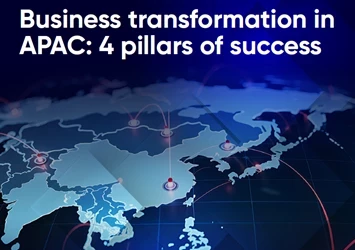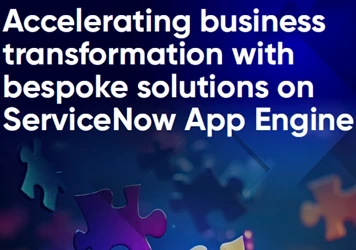How Moderna leveraged lean six sigma to deliver millions of Covid-19 vaccines
Rob Kenny, senior director – operational excellence at Moderna, speaks about the company’s continuous improvement evolution and why it is essential for driving growth
Add bookmark
Moderna, previously a small, pre-commercial biotechnology company, became a household name in January 2020 when it finalized the sequence for mRNA-1273, its Covid-19 vaccine. To support its goal of testing, manufacturing and distributing the vaccine as quickly and safely as possible, Moderna embraced operational excellence and lean six sigma tools.
At the helm of Moderna’s operational excellence strategy was Rob Kenny, the pharma firm’s senior director – operational excellence. With more than 20 years of experience in life sciences and lean six sigma, Kenny was instrumental in evangelizing and formalizing the company’s approach to continuous improvement. As part of these efforts, he paved the way for more than 600 Moderna employees to earn lean six sigma certifications.
firm’s senior director – operational excellence. With more than 20 years of experience in life sciences and lean six sigma, Kenny was instrumental in evangelizing and formalizing the company’s approach to continuous improvement. As part of these efforts, he paved the way for more than 600 Moderna employees to earn lean six sigma certifications.
PEX Network recently caught up with Kenny following his presentation at OPEX Week 2023. In addition to discussing how Moderna’s operational excellence approach helped accelerate the release of its Covid-19 vaccine, he shares how he measures success, drives change and enables continuous learning.
PEX Network: How has Moderna’s approach to operational excellence and continuous improvement evolved over the past three years?
Robert Kenny: I joined Moderna the summer of 2019 when it was a small biotech firm with about 500 employees. — mostly scientists focused on early-stage research and clinical trials. I was the first full-time, operational excellence employee. As such, I was recruited to prepare the organization for the commercialization of its pipeline and its subsequent growth.
In those days, we operated somewhat informally. In a single day I might go from conducting 5S in the lab to sorting through parts on the manufacturing floor to presenting to the CEO.
When the Covid-19 crisis hit, we were still ramping up and building our team. The culture at that time was reactive. Much of our time was spent firefighting, fixing processes as they broke and training business units in operational excellence. We supported the business by identifying and implementing improvement initiatives, but we were not yet proactively leading transformation.
The pandemic and subsequent vaccine development process compelled us to embrace a proactive approach to operational excellence. We now partner with different business functions to proactively identify, plan and staff key improvement initiative months, if not a year, in advance. In addition to scaling lean six sigma methodologies and tools through upskilling, we are also working to add more structure into our governance approach and processes for prioritizing requests.
Following the announcements earlier this year that our Respiratory Syncytial Virus (RSV) vaccine and Personal Cancer Vaccine (PCV) were designated by the FDA as break-through therapies, Moderna announced that it will expand its workforce and add 2,000 new jobs by the end of the year. This bring the organization to 6,000 employees. Growing by 10X within 3 years will further accelerate our need to leverage the operational excellence tools to scale efficiently.
PEX Network: How did you ensure operational excellence strategies drove Moderna’s core mission of developing and distributing a Covid-19 vaccine?
RK: I credit the success of the OE program to my team, who worked incredibly hard, frequently pushed past possible and exceeded all expectations. Achieving cross-functional alignment, however, was easier than you might think because the goal was clear during the pandemic and each employee knew how important our mission was.
The goal was to thoroughly test and safely manufacture the vaccine as fast as possible, while meeting all regulatory requirements, to protect our families and friends. In all of my 20-plus years of professional experience, I have never been in an environment so laser focused.
It was clear that everyone at Moderna and our external partners were fully committed to delivering the vaccine by December 2020. The operational excellence team enabled the achievement of this goal by equipping departments with a common language and approach for rapid team-based problem solving.
Looking forward, Moderna’s longer-term mission is to "deliver the greatest possible impact to people through mRNA medicines". Operational excellence and lean ways of working will amplify our collective efforts towards fulfilling our shared mission.
PEX Network: What advice do you have for other operational excellence leaders tasked with driving change in high-pressure environments?
RK: Success is ultimately about people. First, focus on building a strong team that shares your values and passion for problem solving. I have a great team who truly supports each other across projects. On most days, they even look like they are having fun.
The importance of change management and stakeholder engagement, however, cannot be overstated.
Integrate change management toolsets, methods and skills into your formal strategy to ensure employees at all levels are equipped to design and deploy future-state processes. Proactively communicate with employees, make them part of the change process and empower them to embrace new ways of working before the change even takes place.
PEX Network: What are Moderna’s community of practice and OE Council, and what role do they play in driving operational excellence?
RK: Our community of practice is a group of more than 600 operational excellence practitioners from across the enterprise that gather informally to discuss continuous improvement, share best practices and problem solve.
Moderna’s community of practice has grown to 600 people in two years because people are excited to learn more about operational excellence and lean six sigma. The community of practice was created by people who wanted to continue learning about and working on lean six sigma projects beyond the scope of our formal yellow-belt and green-belt training programs. By joining this network, they can learn about new opportunities to build their problem-solving skills and to participate in continuous improvement projects outside of their immediate functional teams.
To engage our senior leaders, we launched the Operational Excellence (OE) Council. A much smaller group, the OE Council brings together black belts and other OE leaders who are at the forefront of process change. They serve as an intermediary between my team and the community of practice.
As the connection point to the business, the OE Council advises us on our curriculum and strategic priorities.
PEX Network: How do you define and measure success?
RK: Quality, safety and compliance are our three most important goals. We strive to achieve these objectives while also scaling effectively and efficiently to meet patient demand.
My favorite metrics include process cycle-time, work-in-progress and first-time-right. When these three metrics are combined to measure process performance, they drive the right behaviors and outcomes. When you focus on eliminating defects and creating a culture of quality, then cycle-time and cost quickly fall into place.
























